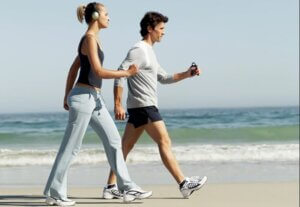Guide to Walking Yourself Thin

Losing weight isn’t just a question of diets, nor is it necessary to harm yourself with overexertion or unnecessary sacrifices. It’s possible to lose weight through other, easier means, ones that offer great results; walking yourself thin is one of those.
Power walking or walking at a brisk pace is one aerobic activity that allows us to quickly burn fat, and as a result, lose weight. When done properly, it becomes yet another recreative moment to help you relax and eliminate stress.
Walking yourself thin: how does it work?
Just like with any physical exercise, walking causes our metabolisms to burn calories. The body needs energy and it gets this from carbohydrates; this way they don’t accumulate as an adipose reserve, which contributes to those round shapes on our bodies that annoy us so much.
Walking yourself thin is the perfect way to increase your base metabolism, which translates into the minimum amount of energy the body needs each day. This way, the muscles burn the fat; which subsequently lowers your overall weight.
What to bear in mind when walking yourself thin

Some choices
First of all, choosing the correct moment to walk is important. Specialists advise against doing it after eating or in moments of intense heat.
If it’s possible, opt for a pleasant route that can even serve as a distraction. Good company and uplifting music are also always effective.
You have to walk relatively quickly
Maintaining a good rhythm is a key factor for the body to burn fat. When we regularly work with high cardiac activities, the body uses the built-up reserves and transforms them into energy.
Every person will find a rhythm that’s suitable for their age and physical state. It’d be ideal to find the speed at which you feel comfortable, but one that works the body. According to the American College of Sports Medicine, the optimum speed for the typical adult is between three and four miles an hour.
However, the activity should increase gradually. If you lead a relatively sedentary life, you should start with short distances and increase them bit by bit.
Walk for at least two and a half hours a week
On a medical, aesthetic, and sports level, specialists suggest a routine of at least two and a half hours a week, split into no more than four sessions. The duration of a session shouldn’t be less than 20 minutes.
Pay attention to your pulse
There are scientists that consider that the intensity is more important than the speed. You can measure the intensity of an exercise through your cardiac rate, and this can be measured by your pulse.
A satisfactory exercise will be that which increases your heart to between 60 and 80 percent of the maximum cardiac frequency. But how can we calculate this? Worry not, there’s a basic formula: your maximum cardiac frequency is the maximum (220) minus your age. This will be the quote to which you apply the 60-80 percent; only by walking with a good intensity will you lose weight.

Technique is important
The more muscles that we include in the activity, the better our fat consumption will be. As such, we advise that you also move your arms during the walk.
You should also strive to breathe deeply whilst exercising. Breathing deeply improves the respiratory capacity that allows the oxygen necessary to complete the exercise to enter the body.
The technique for walking in a suitable way would look something like: head well-positioned, chin parallel to the floor, shoulders back and relaxed, torso straight, and arms flexed at 90 degrees.
Other benefits of walking yourself thin
Not only will you lose weight whilst walking, but you’ll also be contributing to a healthy and balanced lifestyle. In addition to losing weight and getting thin, different studies show that it produces a general activation in the body which favors functional balance, in addition to
- Improving blood circulation.
- Reducing the risks of suffering cardiac diseases, as it strengthens the cardiac system.
- Contributing to balancing the cholesterol level, reducing the risks associated.
- Improving blood pressure control.
- Strengthening bones, tendons, and joints.
- Improving breathing and lung capacity.
- Releasing endorphins, and as such improving your mood, making you feel happier.
- Being a great antidepressant and helping to reduce insomnia.
A good walk with an adequate diet ensures you’ll lose weight and contribute to a better general level of health.
Losing weight isn’t just a question of diets, nor is it necessary to harm yourself with overexertion or unnecessary sacrifices. It’s possible to lose weight through other, easier means, ones that offer great results; walking yourself thin is one of those.
Power walking or walking at a brisk pace is one aerobic activity that allows us to quickly burn fat, and as a result, lose weight. When done properly, it becomes yet another recreative moment to help you relax and eliminate stress.
Walking yourself thin: how does it work?
Just like with any physical exercise, walking causes our metabolisms to burn calories. The body needs energy and it gets this from carbohydrates; this way they don’t accumulate as an adipose reserve, which contributes to those round shapes on our bodies that annoy us so much.
Walking yourself thin is the perfect way to increase your base metabolism, which translates into the minimum amount of energy the body needs each day. This way, the muscles burn the fat; which subsequently lowers your overall weight.
What to bear in mind when walking yourself thin

Some choices
First of all, choosing the correct moment to walk is important. Specialists advise against doing it after eating or in moments of intense heat.
If it’s possible, opt for a pleasant route that can even serve as a distraction. Good company and uplifting music are also always effective.
You have to walk relatively quickly
Maintaining a good rhythm is a key factor for the body to burn fat. When we regularly work with high cardiac activities, the body uses the built-up reserves and transforms them into energy.
Every person will find a rhythm that’s suitable for their age and physical state. It’d be ideal to find the speed at which you feel comfortable, but one that works the body. According to the American College of Sports Medicine, the optimum speed for the typical adult is between three and four miles an hour.
However, the activity should increase gradually. If you lead a relatively sedentary life, you should start with short distances and increase them bit by bit.
Walk for at least two and a half hours a week
On a medical, aesthetic, and sports level, specialists suggest a routine of at least two and a half hours a week, split into no more than four sessions. The duration of a session shouldn’t be less than 20 minutes.
Pay attention to your pulse
There are scientists that consider that the intensity is more important than the speed. You can measure the intensity of an exercise through your cardiac rate, and this can be measured by your pulse.
A satisfactory exercise will be that which increases your heart to between 60 and 80 percent of the maximum cardiac frequency. But how can we calculate this? Worry not, there’s a basic formula: your maximum cardiac frequency is the maximum (220) minus your age. This will be the quote to which you apply the 60-80 percent; only by walking with a good intensity will you lose weight.

Technique is important
The more muscles that we include in the activity, the better our fat consumption will be. As such, we advise that you also move your arms during the walk.
You should also strive to breathe deeply whilst exercising. Breathing deeply improves the respiratory capacity that allows the oxygen necessary to complete the exercise to enter the body.
The technique for walking in a suitable way would look something like: head well-positioned, chin parallel to the floor, shoulders back and relaxed, torso straight, and arms flexed at 90 degrees.
Other benefits of walking yourself thin
Not only will you lose weight whilst walking, but you’ll also be contributing to a healthy and balanced lifestyle. In addition to losing weight and getting thin, different studies show that it produces a general activation in the body which favors functional balance, in addition to
- Improving blood circulation.
- Reducing the risks of suffering cardiac diseases, as it strengthens the cardiac system.
- Contributing to balancing the cholesterol level, reducing the risks associated.
- Improving blood pressure control.
- Strengthening bones, tendons, and joints.
- Improving breathing and lung capacity.
- Releasing endorphins, and as such improving your mood, making you feel happier.
- Being a great antidepressant and helping to reduce insomnia.
A good walk with an adequate diet ensures you’ll lose weight and contribute to a better general level of health.
This text is provided for informational purposes only and does not replace consultation with a professional. If in doubt, consult your specialist.








